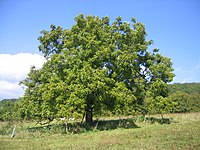
Photo from wikipedia
Abstract This study systematically reviews 146 publications on the socio-economic importance of natural and planted walnut forests in the 15 countries of the Silk Road in order to comprehensively assess… Click to show full abstract
Abstract This study systematically reviews 146 publications on the socio-economic importance of natural and planted walnut forests in the 15 countries of the Silk Road in order to comprehensively assess the current state of knowledge, identify knowledge gaps and define priorities for further research. Despite widely spreading natural and cultivated walnut forests along the Silk Road, which are intensively utilized and make significant contribution to local livelihoods, we found that existing socio-economic research was still relatively limited and unequally distributed among the Silk Road countries, especially for Central Asia and Iran. As evidenced by the significant decline of walnut forests and their continued degradation, past forest conservation policies and programs were often not effective and, therefore, novel strategies and implementation models are urgently needed to achieve sustainable forest management objectives. Our review has shown that conducive economic policies, well-funded national walnut breeding programs and economic incentive schemes could effectively promote the establishment of walnut plantations, which both considerably contribute to the reclamation and rehabilitation of degraded lands and the diversification of farming systems. At the same time, further efforts are needed in walnut research and practice to improve existing value chain arrangements, develop novel products from J. regia and other underutilized forest species, and to more effectively monitor resources and enforce existing legal frameworks. While country-level research gaps seem often to be driven by national agendas and donor interests, we also identified more general topics that did not have received appropriate attention in the literature across all the investigated countries. This includes research on the impact and effectiveness of walnut plantations in reducing pressure on natural walnut forests under land sparing strategies; investigations on the role alternative forms of tourism can play in walnut forest conservation and development; and consumer studies that can provide useful guidance to enterprises in the food processing, cosmetics, handicraft and other industries to improve the quality, value-added and profitability of products derived from the walnut forests. These points illustrate the need for more systematic studies in the walnut forests of the Silk Road countries.
Journal Title: Forest Policy and Economics
Year Published: 2020
Link to full text (if available)
Share on Social Media: Sign Up to like & get
recommendations!